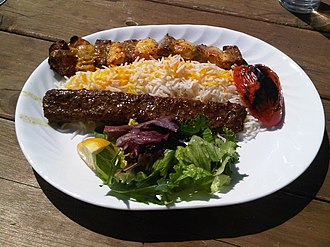Iranian cuisine
Iranian Cuisine[edit]

Iranian cuisine refers to the traditional culinary practices of Iran, characterized by its unique blend of flavors, ingredients, and cooking techniques. It is a reflection of the country's rich cultural heritage and diverse geography, which ranges from arid deserts to lush forests.
History[edit]
Iranian cuisine has evolved over thousands of years, influenced by the various cultures and empires that have ruled the region. The Persian Empire played a significant role in shaping the culinary traditions, introducing ingredients such as rice, saffron, and pomegranate. The Silk Road also facilitated the exchange of spices and cooking techniques with neighboring regions.
Ingredients[edit]
Iranian cuisine is known for its use of fresh herbs, fruits, and spices. Common ingredients include:
- Rice: A staple in Iranian meals, often served as chelow (plain rice) or polow (rice mixed with other ingredients).
- Saffron: Used for its distinct color and flavor.
- Herbs: Such as parsley, coriander, and mint.
- Fruits: Including pomegranate, lime, and plum.
- Nuts: Like pistachios and walnuts.
Dishes[edit]
Kebab[edit]

Kebabs are a quintessential part of Iranian cuisine, with various types such as Kebab Koobideh (minced meat kebab) and Kebab Bakhtyari (a combination of lamb and chicken).
Stews[edit]
Iranian stews, known as khoresh, are slow-cooked dishes that often combine meat with fruits and vegetables. Popular stews include Khoresh-e Fesenjan (pomegranate and walnut stew) and Khoresh-e Ghormeh Sabzi (herb stew).
Breads[edit]

Bread is a staple in Iranian meals, with several varieties such as:
- Naan Sangak: A whole wheat leavened flatbread baked on hot pebbles.
- Taftoon: A thin, soft flatbread.
- Barbari: A thick, oval-shaped bread with a crisp crust.

Desserts[edit]
Iranian desserts often feature ingredients like rose water, saffron, and cardamom. Popular sweets include Baklava, Zoolbia, and Bamieh.
Beverages[edit]
Traditional Iranian beverages include:
- Doogh: A yogurt-based drink, often flavored with mint.
- Sharbat: A sweet, flavored drink made with fruit juices or extracts.
- Chai: Black tea, typically served with sugar cubes.
Culinary Techniques[edit]
Iranian cooking techniques emphasize slow cooking and the use of fresh ingredients. Stews are often simmered for hours to develop deep flavors, while rice is carefully prepared to achieve a fluffy texture.
Related Pages[edit]
Ad. Transform your life with W8MD's Budget GLP-1 injections from $75


W8MD offers a medical weight loss program to lose weight in Philadelphia. Our physician-supervised medical weight loss provides:
- Weight loss injections in NYC (generic and brand names):
- Zepbound / Mounjaro, Wegovy / Ozempic, Saxenda
- Most insurances accepted or discounted self-pay rates. We will obtain insurance prior authorizations if needed.
- Generic GLP1 weight loss injections from $75 for the starting dose.
- Also offer prescription weight loss medications including Phentermine, Qsymia, Diethylpropion, Contrave etc.
NYC weight loss doctor appointmentsNYC weight loss doctor appointments
Start your NYC weight loss journey today at our NYC medical weight loss and Philadelphia medical weight loss clinics.
- Call 718-946-5500 to lose weight in NYC or for medical weight loss in Philadelphia 215-676-2334.
- Tags:NYC medical weight loss, Philadelphia lose weight Zepbound NYC, Budget GLP1 weight loss injections, Wegovy Philadelphia, Wegovy NYC, Philadelphia medical weight loss, Brookly weight loss and Wegovy NYC
|
WikiMD's Wellness Encyclopedia |
| Let Food Be Thy Medicine Medicine Thy Food - Hippocrates |
Medical Disclaimer: WikiMD is not a substitute for professional medical advice. The information on WikiMD is provided as an information resource only, may be incorrect, outdated or misleading, and is not to be used or relied on for any diagnostic or treatment purposes. Please consult your health care provider before making any healthcare decisions or for guidance about a specific medical condition. WikiMD expressly disclaims responsibility, and shall have no liability, for any damages, loss, injury, or liability whatsoever suffered as a result of your reliance on the information contained in this site. By visiting this site you agree to the foregoing terms and conditions, which may from time to time be changed or supplemented by WikiMD. If you do not agree to the foregoing terms and conditions, you should not enter or use this site. See full disclaimer.
Credits:Most images are courtesy of Wikimedia commons, and templates, categories Wikipedia, licensed under CC BY SA or similar.
Translate this page: - East Asian
中文,
日本,
한국어,
South Asian
हिन्दी,
தமிழ்,
తెలుగు,
Urdu,
ಕನ್ನಡ,
Southeast Asian
Indonesian,
Vietnamese,
Thai,
မြန်မာဘာသာ,
বাংলা
European
español,
Deutsch,
français,
Greek,
português do Brasil,
polski,
română,
русский,
Nederlands,
norsk,
svenska,
suomi,
Italian
Middle Eastern & African
عربى,
Turkish,
Persian,
Hebrew,
Afrikaans,
isiZulu,
Kiswahili,
Other
Bulgarian,
Hungarian,
Czech,
Swedish,
മലയാളം,
मराठी,
ਪੰਜਾਬੀ,
ગુજરાતી,
Portuguese,
Ukrainian